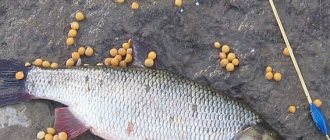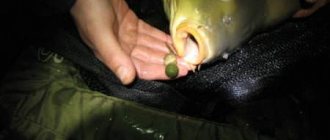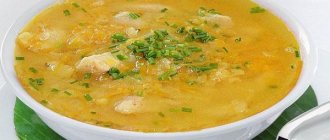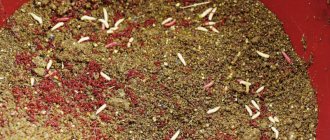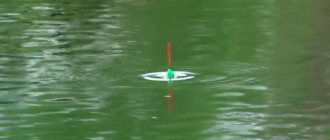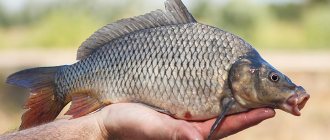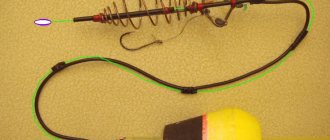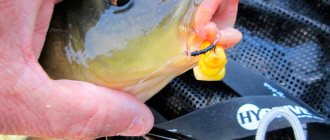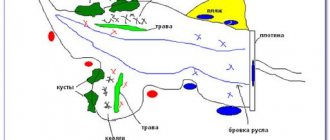Sometimes anglers do not know how to prepare peas for bream fishing correctly, so they rarely use this excellent bait. Bream loves peas; in some reservoirs in the summer you can catch large fish only with the help of such a bait. This attachment helps out when, due to the dominance of small fish, it is impossible to catch with a worm or maggot. Catching bream requires a certain approach to feeding and using baits. Let's look at how to cook peas for bream for baiting and feeding.
Peas for bream
Pea seeds contain a large amount of protein, and fish sense this. Properly prepared, it often works better than the usual corn or pearl barley. Preparation requires some fiddling, so this bait is used less often by fishermen. Bream is one of the obvious connoisseurs of this bait, along with crucian carp and carp. In some reservoirs, fishing for bream with peas is the only possible way to catch fish, especially in the summer, when small slugs simply do not allow the worm to wait for a large fish to approach the hook.
An important feature of bream fishing is that the bait components match the bait used on the hook. If we fish with peas, then this component must also be present in the bait. For bait, whole unshelled peas, regular or larger chickpeas (chickpeas) are used. You can also add whole grains to the bait, but not much - otherwise it will be difficult for the fish to find a hook with a bait in the middle of a clearing covered with large food particles. It is better to cook ordinary split polished peas from a department store as bait for bream, or crush whole ones into porridge. Preparing such a bait requires attention and time, but it pays off in the reservoir with good catches.
Fishing technique
- To catch fish using pea bait, it must be prepared in advance.
- If you plan to fish in a reservoir where carp live, then you need to feed it several days in advance. He's unlikely to bite the first time. Throw the prepared complementary food several times into places where it can live. If it’s not far from the shore, then you can simply scatter it in small portions.
- Feeders are suitable for complementary feeding at a long distance.
And if the carp are found further away, then you can use a feeder. - The baited carp should be caught using whole peas, which are placed on a hook.
- It is necessary to hook periodically, since the fish can unnoticed eat up the bait and bait, especially if the prepared bait does not have such a dense consistency.
- If the fish flies off the hook, you need to take a bait and a harder pea.
- The complementary food that you cooked yourself using peas will be useful for fishing in the last months of summer and early autumn. During this period, fish react more readily to bait and easily leave their habitats.
- In hotter times, the fish tries to stay at the bottom of the reservoir, where it is cooler. And already in the cold season it leaves in search of food. But if you fish in the same place for a long time, then baited fish will be caught all year round.
Whole peas for bait
To attach the hook, whole grains with skins are used, prepared by boiling or steaming, as well as mastyrka, which is a plasticine-like mass. Fish respond well to the smell of peas, no matter how they are cooked. For gear for bream that requires long casting and with active small fish, it is better to use whole grain peas - they simply stay on the hook better, and small fish are not able to swallow them and knock down the bait. On float gear, a softer, dough-like consistency is often used.
To catch bream using peas on the river, you also need to use whole grain, since the mastyrka is washed out over time. There are two ways to prepare peas for bream - boiled or steamed. To steam peas for bream fishing, you need young grains, no older than six months - they boil quickly. The older one needs to be boiled. And this is the most common cooking method. Let's look at how to properly prepare peas for catching bream.
Choosing cereals
Whole unshelled peas are not easy to find in the store. In a department store you may find chickpeas, our larger cousin. However, in terms of cheapness, it is better to look for this product in pet food stores. It is better to stock up in large quantities at once, for example, a bag for a year. This amount is enough for many fishing trips. Peas are perfectly stored and do not lose their properties. It’s just that the older the grain, the longer it will have to be cooked. Steaming in boiling water only works with relatively young grain.
Whole pea grains can also be found on the market. It is better to choose wrinkled peas. Cook it longer. But it does not boil over, and during the cooking process it turns into good whole peas with intact skin, which is what is required for fishing. The seed is available in green, white or orange. For bait, we take white, orange, wrinkled whole peas or large chickpeas (this is even better for large fish - the diameter of the finished grain is 6-8 mm, and for a regular one it is 4-6 mm).
Soaking
Before you cook peas for bream fishing, you need to soak them. The soaking process is required. If you do not do this and cook immediately, the structure of the grain will be disrupted, the skin will burst, and the peas will fall apart. And it will take several hours to cook unsoaked peas. After soaking, the cooking process takes from half an hour to an hour and a half, depending on the age of the seeds.
To soak our future bait, we thoroughly rinse the seed in water and place it in a container with a third of its volume. It could be a can, a bottle, or anything. An approximate calculation is a liter of finished bait (for one rod). This is enough for baiting and adding to bait. When soaked, the peas, taking in water, increase in volume by about 3 times. Thus, to get a liter jar of finished bait, for soaking we take 1/3 of the total volume of seeds and fill it with water until full.
You need to insist for about 12 hours or more, at a temperature no higher than room temperature. In hot weather, peas may begin to sour. Therefore, in the warm season, it is better to put it in the refrigerator for soaking. After about 8-12 hours, the seeds will absorb water, swell and fill the entire volume. You can pour the grain for soaking into plastic bottles and store it in this form in the refrigerator for weeks. This is convenient - if necessary, we take an already soaked product for cooking. This way you can reduce the cooking time.
Cooking
Next, the most important thing is how to properly cook peas for bream fishing. Pour our semi-finished product from the jar into the pan, along with some water. Add water two fingers above the grain (more is possible) and put it on fire. To catch crucian carp at this stage, you can throw a clove of garlic into the pan. However, this aroma does not always affect bream, mostly in cold water. For bream, it is better to add a couple of tablespoons of sugar and a pinch of salt to the pan. The pea aroma itself is a great attractor for bream and carp.
Set the heat to medium, bring to a boil and cook until done. Whole seeds are covered with a thin film, which should not be damaged during the cooking process. Ready peas are pureed inside. The bait is held on the hook by this dense outer layer. The main task when cooking is to ensure that the middle is boiled, and the outer shell remains strong enough and does not fall apart or burst. Stir gently during the cooking process - under no circumstances allow it to burn. And the flip side is that you should not allow changes in the temperature and intensity of boiling, or reduce the heat. As we put it at first, we keep it until the end of the process. Cooking requires attention, it can take up to an hour and a half, but usually from 40 minutes to an hour. We taste readiness with our fingers. The finished pea is whole. But when pressed, it flattens, squeezing out the soft inner part.
When the bait is ready, carefully drain the water and wait a while for it to cool. You can put it on a cloth and dry it a little. You cannot dry it for a long time - the bait will begin to release water and lose its properties. That's all - the best vegetable bait for bream and other large fish of the carp family is ready. We put it in a bag, a jar with a lid and go fishing. We use a small part as a bait, the rest is added to the bait for bream as a feed fraction. After soaking, young peas can not be boiled, but steamed in a thermos, like wheat, or in a saucepan of boiling water, wrapped in a towel.
Pea porridge for roaches
Option 1
Often used when fishing with mandula.
Often this bait is taken by bream, silver bream, crucian carp, tench, carp, carp, but roach still likes this recipe, and, therefore, the main fish in your catch will be roach.
Ingredients
- 500 grams of dry peas.
- 500 grams of semolina.
- A teaspoon of salt.
- A teaspoon of soda.
- A tablespoon of unrefined sunflower oil.
Recipe
- The peas are filled with water so that there is 3-4 cm of water above the peas.
- Add salt and soda.
- Allow the peas to swell for 2-4 hours.
- Place on fire and bring to a boil.
- Reduce heat and cook for one and a half hours.
- Add 250 grams of semolina and mix thoroughly.
- Remove from heat and allow to cool.
- Add the remaining semolina. Mix again.
- Pour in oil.
Option-2
, two medium chago mushrooms are placed in the same pan . This mushroom is taken both fresh and dried. After cooking the peas, the mushroom is removed.
Bream, which can be caught on the current using a bottom fishing rod, will not refuse such pea porridge.
Chago mushroom is also called birch mushroom and is not difficult to find. It appears as black growths on a white tree trunk.
You can also add dill seeds or its young leaves to the prepared pea porridge.
Peas for bream in bait
The next task is to make groundbait based on peas. As already mentioned, the main secret of how this bait works is working in pairs. It must be present on the hook and in the bait at the same time. It’s easier with bait - you don’t need to worry about the integrity of the grain. On the contrary, you don’t need a lot of whole grains for bream (this will distract the fish’s attention from the bait). If there is a lot of whole cooked chickpeas, then most of them can simply be twisted into porridge and added to the mass - the pea bait for bream is ready.
If there are not enough whole grains, you can cook them a little for attachment. For bait, we prepare ordinary pea porridge for bream fishing from half-polished grain from the store. The process is similar to preparing whole grains - soak for 8-12 hours, then cook, only not so thoroughly, but completely, until pureed. We then use this mass to add to bait or to prepare pea mastyr for bait on a fishing rod. Mastyrka is usually used for fishing rods if there are no intact unhulled grains. Even on a float fishing rod, whole grains work better - the bait stays on the hook better and is not eaten away by small things.
During the cooking process, when the peas begin to fall apart, you can add millet to them. Cook for another 10-15 minutes, and we get the basis for baiting bream from peas and millet. Groundbait made from this ingredient also contains a middle fraction - millet grains. The process of further mixing depends on the conditions and for what gear the bait will be used.
Feeder and bottom fishing
When prepared, pea bait for bream for feeder fishing should mold well, but fall apart when pressed. This is due to the special tactics of the feeder - frequent recasts and constant feeding of one point. Therefore, we break up pea puree or porridge with a loose, small component - breadcrumbs, ground cake or store-bought mixtures. As a result, we get a fairly loose mixture, which molds when compressed to fill the feeder.
When fishing for bream in the current, you need a more viscous mixture so that it does not wash out immediately. But still, it should not lie like a dead weight at the bottom, but over time collapse and release the feeder. The right pea bait for bream in summer can also attract large crucian carp and carp to the point. Be sure to add a certain amount of large whole grains to the mixture for bream, as on a hook, so that the fish begins to eat them and purposefully search for them among the small particles of the rest of the feeding. We do the same with millet and pea porridge for feeder fishing. Read more about feeder bait for bream.
You can prepare and boil peas while fishing for bream for bait and bait right on the pond, on a fire, or during multi-day trips. It’s just that in the heat, after one day of fishing, the pre-prepared bait and bait may deteriorate. In some reservoirs it has been noticed that bream and carp react well only to fresh, recently cooked peas.
The consistency of bream bait for donks, when hammering it into springs, watermelons or nipples, requires a more viscous consistency, similar to plasticine. The main tactics of donkeying are casting and waiting. Therefore, the porridge should not be washed out quickly, waiting for the bream to approach. Therefore, we mix a few small components into this fertilizing, just to remove excess moisture. All these mixtures can also be used when fishing for bream with a ring from a boat.
Features of spring fishing
Spring equipment
To get a good catch, it is not enough to prepare a tasty bait; you will also need to pay attention to the equipment of the spring.
Its features depend on the type of fish that is the fisherman’s main goal: small and compact springs are used to catch crucian carp; for fishing for carp and other strong fish - larger and more durable models.
The most universal equipment looks like this:
- Leashes are required; their number can be from 2 to 6 pieces. The length is no more than 5 cm; the main material is a braided cord with a large diameter or a nylon thread.
- Hooks No. 4-9, they are selected individually depending on the expected weight of the prey.
- In some cases, the spring is equipped with a sinker, then the hooks should be attached directly to the tackle.
- The average weight of sinkers varies from 30 to 50; if they are not on the tackle, they are attached to the end of the fishing line, after which several small springs are mounted, and leashes with hooks are tied around them.
- The rod can be of any type, the recommended length is from 2 to 3.5 meters; test value is at least 40g.
- The standard supply of working line is 100 meters, diameter from 0.25 to 0.3 mm.
- A bell or electronic alarm signaling the start of a bite.
- Inertia-free reel, size 3000-4000. It is recommended to choose models equipped with a baitrunner.
Types of springs
Depending on the shape, dimensions and features of the equipment, there are three most popular types of springs:
- A “donut” is a long spring that can curl into a ring. The base has a diameter of no more than 1.5 cm, and when compressed, a ring of up to 5 cm is formed; First, a common leash is attached to the tackle, and the required number of additional leashes is already attached to it.
- The “combine” or cone spring has the appropriate shape; all leads are fastened to the top of the cone. The tackle is compact in size and easy to use, so it is perfect for beginner fishermen.
- “Crucian carp killer” is distinguished by a design in which fundamental changes are made: three springs are attached one after another, and sinkers are excluded from the equipment. A standard leash equipped with a hook No. 4-6 is attached to each spring; a distance of at least 12 cm must be maintained between them. The main sinker is attached directly to the free end of the fishing line; its weight is selected individually and can range from 20 to 50g.
Spring fishing tips
Baits are selected individually depending on the type of prey, time of year and preferences of the fish living in a particular reservoir.
Typically, the following types of attachments show good results:
- Fresh green peas.
- Corn grains.
- Maggot.
- Bread crumb balls.
- Earthworms or dung worms.
- Maggot.
- Regular foam.
Spring with foam
When fishing on reservoirs with a muddy bottom structure, springs with foam are effective; this technique is practiced if the prey behaves passively and does not want to peck when using classic baits.
The fishing scheme will be as follows:
- The selected fishing point is fed generously with porridge or other mixture.
- A foam ball is placed on each hook, the tip should remain open.
- A cast is made to the feeding area.
Fishing with a spring in the current
Using a spring in areas of a reservoir with a rapid current greatly complicates the fishing process, since the tackle quickly moves to a new place.
To prevent possible problems, you will need to take the following measures:
- Increase the weight of the spring depending on the strength of the current.
- Use the most thick and viscous porridges that will not be washed out of the spring in a matter of minutes.
bolshoyulov.ru
Float fishing
On small rivers, lakes and from a boat, you can also catch bream using a float, if the depth and current allow. In this case, feeding is done with balls directly into the fishing area. To do this, you can use either porridge or throw whole grains in bulk into the fishing zone. Naturally, the strength of the current is taken into account. The hook with the nozzle must be located in the feeding spot on the bottom, otherwise the bream that comes up for bait will not find the nozzle lying alone on the side. We place whole boiled peas or mastyrka on the hook. The consistency of pea bait for bream for a float is selected based on the fishing conditions. On lakes where there is no current, a crumbly mixture is needed, as for a feeder.
You need to adjust the consistency so that the balls reach the bottom intact and begin to fall apart on the spot. If they become very dusty in the depths, they are more likely to attract roach rather than bream. In a current, a more viscous consistency is needed in order to slowly fall apart at a point and form a stern plume in the direction of the flow. Preparing peas for bream fishing should always be thoughtful and based on the upcoming fishing features and the gear used.
Hair rig
Recipe for peas for fishing No. 3
The third method is a water bath. Again, pre-soak the pea seeds overnight. Afterwards, drain it in a colander and place it in a saucepan where freshly boiled water should be prepared. Cover everything tightly with a lid and let it steam.
Tips and conclusions
• If you fish for peas, use thin, sharp hooks so that when you hook them, they don't fall apart in two. • Place the pea on the hook in the place of the sprout, as shown in the photo • Already cooked peas can easily and quickly spoil. Keep away from sun. • Use whole peas to bait the hook. If necessary, you can attach several pieces. • Cooked peas store well in the freezer. To use it for fishing, just defrost it. • Can be fished all year round
Canned or young peas
In float fishing, you can use canned or live young peas from the bush. This bait easily gets knocked off the hook, so it is not used on long-distance casting gear. You can use canned peas for bream when fishing carefully with a fishing rod. Such bait can usually be pecked in summer in warm water. If there is no dominance of small fish that quickly knock down this delicate bait, its use is justified. If you don’t want to bother with cooking, then it’s better to buy ready-made boiled whole peas for fishing, and add porridge to the bait.
Chickpeas for carp fishing
This variety of peas is especially common in the Far East; in our country it is sold in the spice department. Chickpeas for fishing are prepared in almost the same way as any other peas, but you should not soak them for a long time, they will turn sour.
It is not recommended to use chickpeas as a feed. The fish quickly becomes saturated with it and does not approach the bait. The bait performs especially well on hot days, while carp bites are observed much more often than peas, probably due to the smaller size of the latter.
Fermented peas
Fermented peas are used less frequently. Some anglers claim that fermented corn works well on fish, but sour peas work poorly. However, there is information that sometimes they bite well on fermented peas. It is better not to experiment with bream and fermentation - you can only scare away the fish. It has long been proven by experience that bream almost always and everywhere react positively to ordinary boiled peas. It is better to bother with fermentation when fishing for carp, carp or crucian carp.
